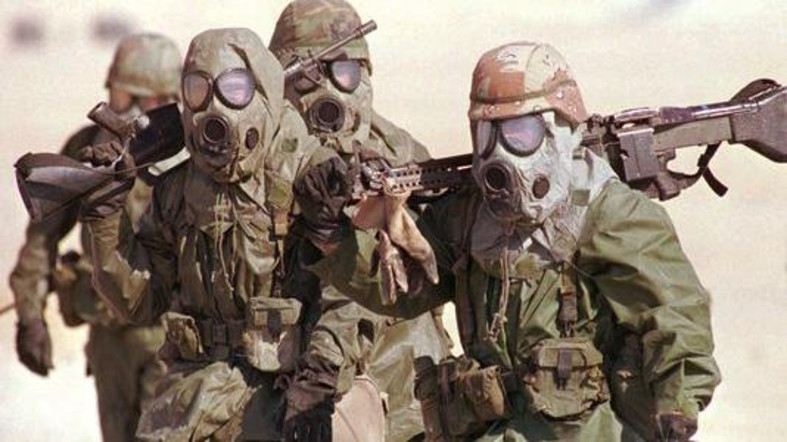 Joyce Riley was a Registered Nurse who served in the Gulf, and is now appalled at the range of runaway symptoms. From all the cognitive problems to all the digestive ones and beyond, to mycoplasma infections to overriding fatigue, not too mention the pattern of birth defects in children whose parents served in the Persian Gulf, the numbers have been overwhelming.
Joyce Riley was a Registered Nurse who served in the Gulf, and is now appalled at the range of runaway symptoms. From all the cognitive problems to all the digestive ones and beyond, to mycoplasma infections to overriding fatigue, not too mention the pattern of birth defects in children whose parents served in the Persian Gulf, the numbers have been overwhelming.
If Truth is the first casualty of war it stands to reason that all wars have their secrets hidden away in history, like a locked box in the far corner of an attic. Questions and answers for us to contemplate years later. Questions of loyalty and betrayal as the pressures of war cause shifting alliances. And key figures at the time, what did they know and when did they know it? Who had intelligence, never revealed, of what the enemy might be doing?
The Gulf War of the 1990’s may harbor all those rich historical uncertainties, but it contains a broader mystery, especially for the winning side, the American side. Namely, why did almost a third of the returning troops, over 200,000 men and women, return from the Gulf with unexplained symptoms, medical symptoms that may be with them for life?
It was much talked about at the time, the so-called Gulf War Syndrome. Complaints to the Veteran’s Administration health system were stacked high in it’s files, keeping the system clogged for months on end. Returning veterans complained of fatigue, pain in their joints, headaches, and mental distress such as trouble with memory and cognition, among other symptoms.
In the early years after the conflict, the Department of Defense was largely in denial. “Department of Defense physicians have found no clinical evidence of a unique illness,” was the standard press release until evidence mounted. The numbers of those showing symptoms from among a consistent menu finally overwhelmed the system and forced recognition that something had chronically affected the health of veterans.
Veteran’s Administration authorities still don’t know, they say, exactly what caused the cluster of symptoms. But as the years have gone by, it’s become harder and harder to pretend that the phenomenon has not been consistently real. “Proof Gulf War Illness Does Exist” stressed the title of an article from a few years back (begging the question of why anyone would question that it does). Even brain tissue volumes were affected in symptomatic individuals, the study concluded!
Roberta White, PhD, of Boston University School of Public Health and colleagues reported in 2007 that Gulf War veterans who returned with multiple symptoms and complaints were found to have significant differences in brain structures compared to their fellow returnees. Dr. White presented their findings at the American Academy of Neurology’s 59th Annual Meeting in Boston (2007).
The researchers had recruited 36 veterans from the 1990-1991 Gulf War (the first Gulf War). More than five of them had multiple symptoms, including difficulty concentrating, nausea, skin rash, headaches, forgetfulness, fatigue and joint pain. The rest had fewer than five symptoms.
Dr. White explained that two regions of the brain involved in thinking and memory were considerably smaller in those with more than five symptoms – the overall cortex was 5% smaller and the rostral anterior cingulated gyrus was 6% smaller. She said “We don’t know the cause of these differences in the veterans’ brain volumes, but the hypothesis is that they are related to exposure to hazardous substances during the first Gulf War. Many troops were exposed to hazardous substances such as pesticides, and other studies have shown that exposures to these substances affect the central nervous system.
So, even measurable science has demonstrated that the Gulf War Syndrome does not spring from the over-active imaginations of the veterans. But what, just what has caused all that misery, all these years, for all those veterans?
It’s remarkable, in fact, to look at the articles over the years about the syndrome. An astounding number of them use the word mystery to describe the fate of 200,000 and more veterans.
 The list of possible triggers associated with the veteran’s agonies is long and includes everything from air particulates from burning oil wells to the over-vaccination of troops to radiation from Depleted Uranium weaponry to pesticide exposure, and more. Somewhat more quietly discussed, in the background, is the possibility of chemical warfare waged by Saddam Hussein. At the time it was announced with relief that Iraqi forces had not stooped to the use of chemical weapons, the equivalent of a nuclear option. And yet as the years go by, it seems quite possible that traces of weaponized chemicals, perhaps sarin gas and other destructive substances, were in the mix.
The list of possible triggers associated with the veteran’s agonies is long and includes everything from air particulates from burning oil wells to the over-vaccination of troops to radiation from Depleted Uranium weaponry to pesticide exposure, and more. Somewhat more quietly discussed, in the background, is the possibility of chemical warfare waged by Saddam Hussein. At the time it was announced with relief that Iraqi forces had not stooped to the use of chemical weapons, the equivalent of a nuclear option. And yet as the years go by, it seems quite possible that traces of weaponized chemicals, perhaps sarin gas and other destructive substances, were in the mix.
Steve Robinson was a former director of the National Gulf War Resource Center, essentially charged with delivering the public relations message of the Pentagon. He looks back on those days with distain—he simply doesn’t believe that the DOD was committed to honest and accurate accounting for the GWS sufferers,
And all of this begs the question: Just how much more will we ever learn about the Gulf War Syndrome? Are there documents salted away that need to be exposed, or can a solid analytical process yield some truth, at last?
We haven’t heard the end of the illnesses triggered by service in the Persian Gulf.













